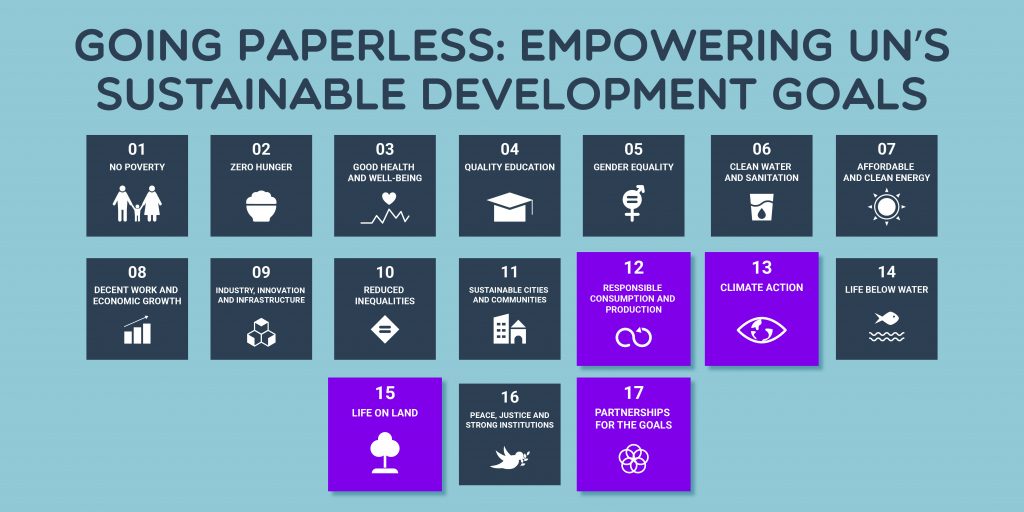
As human society and the world continues to grow, we are faced with the inevitable: environmental and sustainability challenges. Mother Earth’s resources are limited and that is a stated fact; which is a double-edged sword for us. In exchange for sustaining our survivability and every day necessities, the Earth’s natural resources are consumed to a degree. But fear not, the United Nations Sustainable Development is a framework to help address the global challenges in achieving sustainable development and for our future. Among the 17 goals, going paperless is a valuable goal for businesses, organizations, and individuals alike. Going paperless helps achieve goals 12, 13, 15, and 17 for a sustainable future. By going paperless and taking advantage of digital technologies, we can hugely reduce paper consumption and the resources involved along the process.
What is the United Nations Sustainable Development Goals
The United Nations Sustainable Development Goals (SDGs) are a set of 17 global goals established by the United Nations in 2015.
They are designed to address the global challenges and guide international efforts toward a more sustainable, equitable, and prosperous future.
The SDGs cover various aspects of social, economic, and environmental development, aiming to achieve a balance that benefits both people and the planet.
The 17 Sustainable Development Goals are:
- No Poverty
- Zero Hunger
- Good Health and Well-being
- Quality Education
- Gender Equality
- Clean Water and Sanitation
- Affordable and Clean Energy
- Decent Work and Economic Growth
- Industry, Innovation, and Infrastructure
- Reduced Inequality
- Sustainable Cities and Communities
- Responsible Consumption and Production
- Climate Action
- Life Below Water
- Life on Land
- Peace, Justice, and Strong Institutions
- Partnerships for the Goals
In this article, we will focus on how businesses, organizations, and individuals alike can help achieve goals 12, 13, 15, and 17 of the United Nations Sustainable Development by going paperless.
What Does “Going Paperless” Mean?
Going paperless refers to the process of transitioning from traditional paper-based methods to digital or electronic alternatives. In various contexts, organizations and individuals are adopting paperless practices to reduce reliance on paper and pulp, streamline processes, and embrace more sustainable and efficient approaches.
In a business or organizational setting, going paperless typically involves digitizing documents, utilizing electronic communication and collaboration tools, and implementing digital workflows.
This can include activities such as using digital signatures, quotations, e-procurement, storing documents in a cloud database, and conducting transactions electronically rather than on paper.
According to The World Counts, here are critical metrics to follow:
- More than 199 tons of paper has already been produced (paper production in 15 seconds).
- 2,700 liters of water is used to make 1 tonne of paper (average for the European industry).
- 1 sheet of paper requires 2 to 13 liters of water (depending on the mill).
- 93% of paper comes from trees.
Goal 12: Responsible Consumption and Production
Goal 12 of the United Nations Sustainable Development Goals (SDGs) is “Responsible Consumption and Production.” It aims to ensure sustainable and efficient consumption patterns, emphasizing the need to do more with less and promoting responsible management of natural resources.
The paper and paperboard consumption last 2023 was around 420 million metric tons. And this year, it is projected to reach 427 million metric tons. In the worst case scenario, where we don’t take action on reducing paper consumption and production by 2032, the estimated consumption would reach 476 million metric tons, according to Statista.
But no need to panic! Going paperless aligns closely with achieving this goal by promoting more sustainable and responsible practices.
Going paperless minimizes paper consumption for documentation, communication, and transactions. This directly contributes to reducing the demand for paper production, lowering the environmental impact associated with deforestation, water usage, and energy consumption in paper manufacturing.
Goal 13: Climate Action
Goal 13 of the United Nations Sustainable Development Goals (SDGs) is “Climate Action.” It focuses on urgent measures to combat climate change and its impacts.
Paper production and transportation contribute to carbon emissions. Going paperless eliminates or minimizes the need for these processes, directly reducing the carbon footprint associated with the paper industry.
As per the International Energy Agency, the pulp and paper industry accounted for slightly less than 2% of total emissions in the year 2022.
The extensive production and consumption of paper pose significant environmental challenges, depleting natural resources, contributing to deforestation, and demanding substantial energy. Paper production heavily relies on water and raw materials, straining ecosystems and perpetuating the depletion of natural resources.
The reliance on wood pulp for paper leads to deforestation, disrupting biodiversity and escalating climate change. Additionally, the energy-intensive nature of paper production exacerbates environmental impacts, contributing to greenhouse gas emissions.
Going paperless is pivotal, as it not only streamlines processes but also addresses these environmental concerns by conserving resources, protecting forests, and reducing energy demands.
Adopting a paperless approach significantly contributes to achieving Goal 13 by mitigating environmental impact and reducing the carbon footprint associated with paper usage.
Going paperless presents a transformative solution to mitigate the environmental impacts of paper production and consumption. By embracing digital alternatives, organizations reduce the demand for paper, directly lessening the strain on natural resources such as water and wood pulp.
Goal 15: Life on Land
Every year, 10 million hectares of trees get chopped down to make space to grow crops, livestock, and produce paper, according to Earth.org.
Goal 15 of the United Nations Sustainable Development Goals (SDGs) is “Life on Land.” It aims to protect, restore, and promote the sustainable use of terrestrial ecosystems, halt deforestation, combat desertification, and reverse land degradation.
The goal also addresses biodiversity loss and strives to ensure the conservation of ecosystems, fostering resilience and sustainable practices for the benefit of both people and the planet.
The 15th SGDs is intimately connected to the practice of going paperless, as traditional paper production has substantial implications for terrestrial ecosystems. Paper, primarily derived from trees, necessitates extensive land use and contributes to deforestation.
By going paperless, we directly alleviate the pressure on forests and the land they occupy. This shift not only preserves crucial biodiversity and habitats but also aids in preventing land degradation, a key aspect of Goal 15.
Additionally, reducing the demand for paper lessens the need for large-scale land conversion into plantations, ultimately supporting the sustainable use of terrestrial ecosystems.
Goal 17: Partnerships for the Goals
Goal 17 of the United Nations Sustainable Development Goals (SDGs) is “Partnerships for the Goals.” This goal underscores the importance of collaborative and inclusive partnerships among governments, businesses, civil society, and other stakeholders to achieve the broader sustainable development agenda. It emphasizes the need for collective action, cooperation, and shared resources to address complex global challenges.
The government sector, businesses and organizations have one thing in common, yes you get that right, the everyday use of paper.
Through the unified efforts of these three major entities working towards the shared objective of going paperless, there is a potential for a gradual yet profound reduction in the demand for paper production, consumption, and resultant waste. This collective endeavor holds the promise of saving millions of hectares of trees, substantial amounts of energy, and significant volumes of water resources.
How Shoppable Business Contribute to Empowering UN’s SDGs
You might ask, how does a B2B e-Procurement platform / eCommerce marketplace in the Philippines, Shoppable Business, contribute to empowering goals 12, 13, 15, and 17 of UN’s sustainable development goals?
The answer is very simple; Shoppable reduces the need for print paper quotations, savings trees and the overall resources needed to produce paper, which meets the needs of goals 12, 13, 15, and 17 of the United Nations Sustainable Development Goals.
A not-so-fun fact: 50% of business waste comes from paper, which represents how much paper is consumed by businesses and organizations alike on their day-to-day operations. By digitizing your procurement process, you can take part in promoting and empowering UN’s SDGs.
Shoppable Business digitizes businesses with its procurement process, from quotations, approvals, and everything in between purchase requisition to sales invoice and record keeping. This means, businesses won’t have to physically procure products and services, as it can be done digitally, which consequently lands on going paperless, transforming papers to pixels.
Going paperless meets the needs of goals 12, 13, 15, and 17 of the United Nations Sustainable Development Goals to be realized. And with Shoppable Business’ contribution to the digital transformation of procurement, invoicing, and record keeping, this helps promote sustainable eCommerce and the campaign of going paperless, empowering UN’s SDGs.
Conclusion
Going paperless is only a small page of the entire book of solutions in promoting the UN’s sustainable development goals as there are also various factors that contribute to the environment and natural resources challenge. But it always takes a single step in realizing a goal.
Going paperless minimizes the need to cut down 10 million hectares of trees, great energy usage, and the use of water in producing, manufacturing, and consumption of paper. By empowering this campaign, going paperless saves the environment, minimizes waste, leading to a sustainable future.









